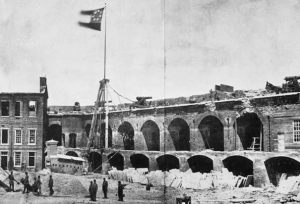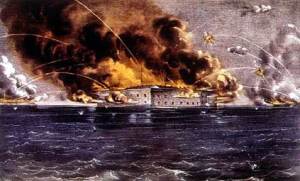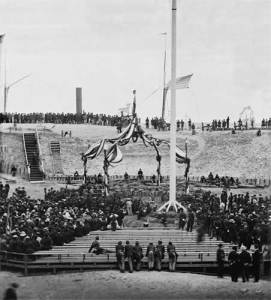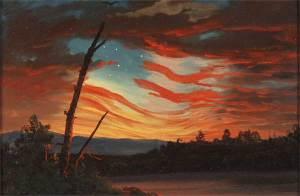Lincoln and flags as his death approached
 One hundred and fifty years ago, in the closing weeks of his life, Abraham Lincoln was focused on the finale of the Civil War – and on flags. On March 17, 1865, for example, he issued an address to the 140th Indiana Volunteer Infantry, which had captured a rebel flag during a battle in North Carolina.
One hundred and fifty years ago, in the closing weeks of his life, Abraham Lincoln was focused on the finale of the Civil War – and on flags. On March 17, 1865, for example, he issued an address to the 140th Indiana Volunteer Infantry, which had captured a rebel flag during a battle in North Carolina.
Saying he was “glad” about the flag’s being taken, Lincoln went on to quip that “whenever I hear anyone arguing for slavery, I feel a strong impulse to see it tried on him personally.”

Ten days later, with the Confederacy near collapse, Secretary of War Edwin Stanton informed the President that the same U.S. flag lowered when Fort Sumter surrendered to the rebels in 1861 and the war began would be raised again on April 14, precisely four years after the loss.
In reply, a lawyerly Lincoln called attention to a flaw in the plan. “The surrender of Fort Sumter was on the 13th of April,” he said. But the date of the upcoming commemoration was fine, he added, because “the evacuation actually took place” on the 14th.

On March 31, with Lincoln’s assassination just two weeks away, General U.S. Grant telegraphed the President to promise, “I will send you a rebel flag captured by our troops in driving the enemy back. There has been four flags captured today. The one I send you was taken from a [Virginia] regiment.”

It is a tragic irony that Lincoln was shot on April 14, 1865, the same day as the restoration of the American flag to Fort Sumter in the harbor of Charleston, South Carolina. A newsman wrote that “the great event of raising the old flag attracted a large number of visitors.” He added that “the national flag was suspended from all the public and many private buildings” in Charleston.
In the harbor, the journalist continued, “the national ensign floated from all the old rebel forts…except Fort Sumter” until the formal ceremony was held to mark the end of the War Between the States.

After much ceremony, several hands “unfurled the glorious old banner amid the deafening cheers of the assemblage” in the fort, he said.
If Lincoln knew those happy details, it wasn’t for long. He was assassinated that same evening and died the next morning. Flags that had been so joyously raised were then lowered in sorrow.
